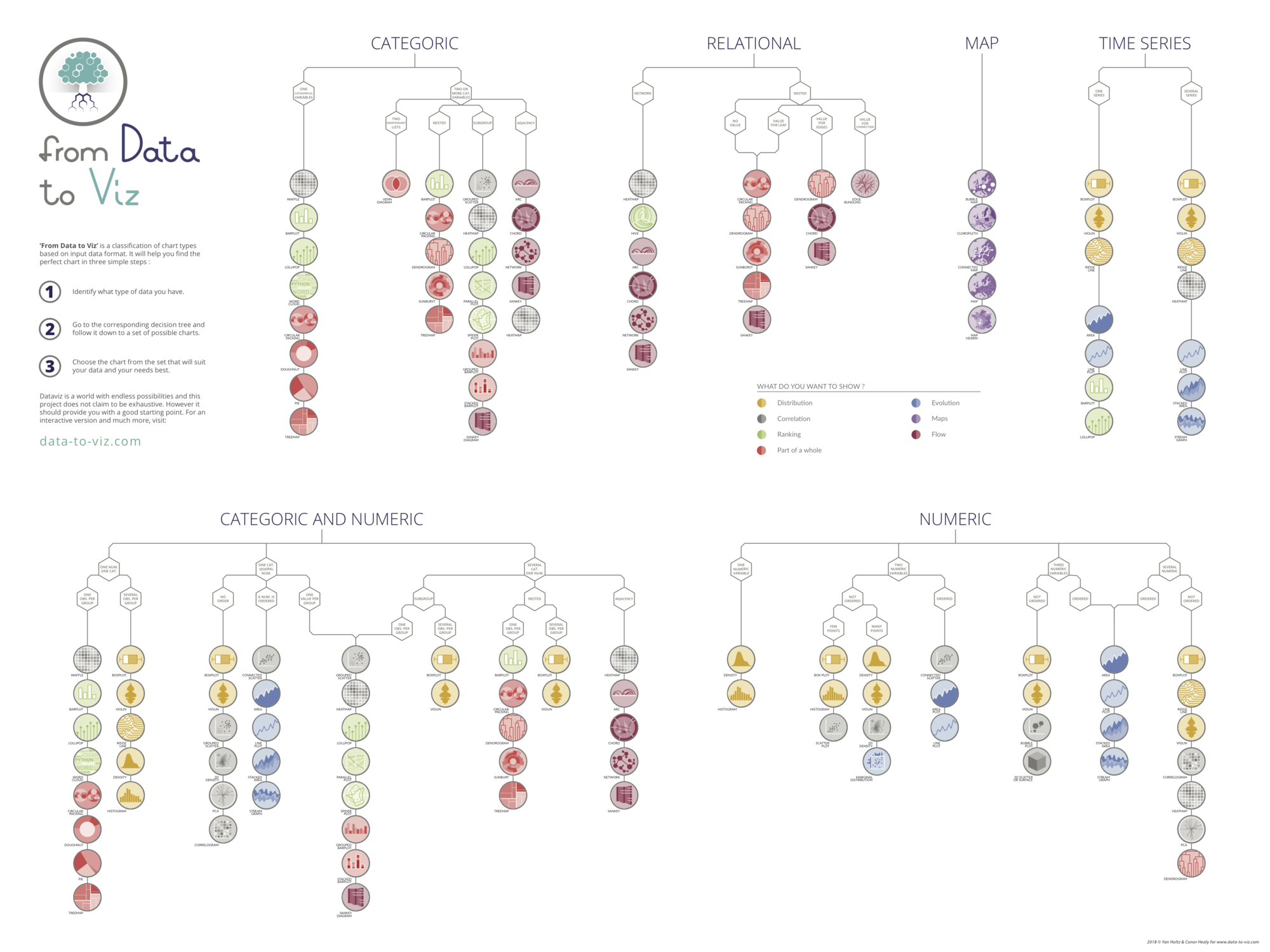The data
Let's get started by importing libraries and loading the data
import matplotlib.pyplot as plt
import numpy as np
import pandas as pd
data = pd.DataFrame(
{
"value": [364, 232, 143, 357, 204, 131, 254, 158, 91, 196, 122, 74],
"category": [
"West",
"West",
"West",
"East",
"East",
"East",
"Central",
"Central",
"Central",
"South",
"South",
"South",
],
"sub_category": [
"Consumer",
"Corporate",
"Home office",
"Consumer",
"Corporate",
"Home office",
"Consumer",
"Corporate",
"Home office",
"Consumer",
"Corporate",
"Home office",
],
}
)
cat_order = ["West", "East", "Central", "South"]
data["category"] = pd.Categorical(data["category"], categories=cat_order, ordered=True)
data = data.sort_values(["category", "value"], ascending=[True, False])The dataset looks like this:
data| value | category | sub_category | |
|---|---|---|---|
| 0 | 364 | West | Consumer |
| 1 | 232 | West | Corporate |
| 2 | 143 | West | Home office |
| 3 | 357 | East | Consumer |
| 4 | 204 | East | Corporate |
| 5 | 131 | East | Home office |
| 6 | 254 | Central | Consumer |
| 7 | 158 | Central | Corporate |
| 8 | 91 | Central | Home office |
| 9 | 196 | South | Consumer |
| 10 | 122 | South | Corporate |
| 11 | 74 | South | Home office |
Default grouped barplot
pivot_dfreshapes the data so that each row is a category and each column is a sub-category.xgives the base x-positions for the categories.- The
forloop goes through each sub-category and offsets its bars horizontally usingi * bar_widthso they appear grouped. - Each
ax.bar()call draws one set of bars (for one sub-category) at the correct shifted position.
pivot_df = data.pivot(index="category", columns="sub_category", values="value")
fig, ax = plt.subplots(figsize=(7, 5))
bar_width = 0.25
x = np.arange(len(pivot_df.index))
for i, sub_cat in enumerate(pivot_df.columns):
ax.bar(x + i * bar_width, pivot_df[sub_cat], width=bar_width, label=sub_cat)
ax.set_xlabel("Category")
ax.set_ylabel("Value")
ax.set_title("Regions - Revenue by Segment", loc="left")
ax.set_xticks(x + bar_width / 2)
ax.set_xticklabels(pivot_df.index)
ax.legend(title="Sub Category")
plt.show()Total values in the background
This version adds total bars behind the grouped bars.
- It first calculates
totalsfor each category (sum across sub-categories). ax.bar(x, totals, ...)draws wide, light grey bars as a background, showing the total per category.- The
forloop then overlays the narrower, colored bars for each sub-category, centered around each category position.
So while both use a loop to draw grouped bars, this one also visualizes the total, making it easier to compare individual sub-category values to the whole. The offset (i - 0.5) * bar_width ensures the grouped bars are centered over the total bar.
pivot_df = data.pivot(index="category", columns="sub_category", values="value")
totals = pivot_df.sum(axis=1)
fig, ax = plt.subplots(figsize=(7, 5))
bar_width = 0.25
x = np.arange(len(pivot_df.index))
ax.bar(x, totals, width=bar_width * 3.5, color="lightgrey", zorder=0, label="Total")
for i, sub_cat in enumerate(pivot_df.columns):
ax.bar(
x + (i - 1) * bar_width,
pivot_df[sub_cat],
width=bar_width,
label=sub_cat,
zorder=1,
)
ax.set_xlabel("Category")
ax.set_ylabel("Value")
ax.set_title("Regions - Revenue by Segment", loc="left")
ax.set_xticks(x)
ax.set_xticklabels(pivot_df.index)
ax.legend(title="Sub Category")
fig.savefig(
"../../static/graph/grouped-barplot-with-the-total-of-each-group-represented-as-a-grey-rectangle.png",
dpi=100,
bbox_inches="tight",
)
plt.show()Customization
Let's make it look nicer!
from highlight_text import fig_text
pivot_df = data.pivot(index="category", columns="sub_category", values="value")
totals = pivot_df.sum(axis=1)
fig, ax = plt.subplots(figsize=(7, 5))
bar_width = 0.25
x = np.arange(len(pivot_df.index))
colors = ["#E0AC2B", "#E85252", "#6689C6"]
x = np.arange(len(pivot_df.index))
ax.bar(x, totals, width=bar_width * 3.5, color="#E0E0E0", zorder=0)
for i, sub_cat in enumerate(pivot_df.columns):
ax.bar(
x + (i - 1) * bar_width,
pivot_df[sub_cat],
width=bar_width,
zorder=1,
color=colors[i],
)
ax.set_xticks(x)
ax.set_xticklabels(pivot_df.index)
ax.set_yticks(list(range(0, 801, 100)))
ax.spines[["top", "right", "bottom"]].set_visible(False)
ax.tick_params(axis="x", size=0, pad=10)
ax.tick_params(axis="y", labelsize=8)
fig.text(x=0.12, y=1, s="Regions - Revenue by Segment", size=14)
fig_text(
x=0.12,
y=0.97,
s="<Consumer> <Corporate Home> <Office>",
highlight_textprops=[
{"color": colors[0]},
{"color": colors[1]},
{"color": colors[2]},
],
)
fig.savefig(
"../../static/graph/grouped-barplot-with-the-total-of-each-group-represented-as-a-grey-rectangle-2.png",
dpi=100,
bbox_inches="tight",
)
plt.show()
Label values
The very last step in improving this graph is to add the values for each sub-category and each overall category. The key is to use for loops to dynamically add these labels.
pivot_df = data.pivot(index="category", columns="sub_category", values="value")
totals = pivot_df.sum(axis=1)
fig, ax = plt.subplots(figsize=(7, 5))
bar_width = 0.25
x = np.arange(len(pivot_df.index))
colors = ["#E0AC2B", "#E85252", "#6689C6"]
ax.bar(x, totals, width=bar_width * 3.5, color="#E0E0E0", zorder=0)
for i, sub_cat in enumerate(pivot_df.columns):
values = pivot_df[sub_cat]
ax.bar(
x + (i - 1) * bar_width,
values,
width=bar_width,
zorder=1,
color=colors[i],
)
for j, val in enumerate(values):
ax.text(
x[j] + (i - 1) * bar_width,
val + 5,
f"{val:.0f}",
ha="center",
va="bottom",
fontsize=8,
)
for i, total in enumerate(totals):
ax.text(
x[i],
total + 10,
f"{total:.0f}",
ha="center",
va="bottom",
fontsize=9,
color="#555555",
)
ax.set_xticks(x)
ax.set_xticklabels(pivot_df.index)
ax.set_yticks(list(range(0, 801, 100)))
ax.spines[["top", "right", "bottom"]].set_visible(False)
ax.tick_params(axis="x", size=0, pad=10)
ax.tick_params(axis="y", labelsize=8)
fig.text(x=0.12, y=1, s="Regions - Revenue by Segment", size=14)
fig_text(
x=0.12,
y=0.97,
s="<Consumer> <Corporate Home> <Office>",
highlight_textprops=[
{"color": colors[0]},
{"color": colors[1]},
{"color": colors[2]},
],
)
fig.savefig(
"../../static/graph/grouped-barplot-with-the-total-of-each-group-represented-as-a-grey-rectangle-3.png",
dpi=100,
bbox_inches="tight",
)
plt.show()Going further
- Learn more about barplots
- How to create a stacked barplot
- How to create a percent stacked barplot







